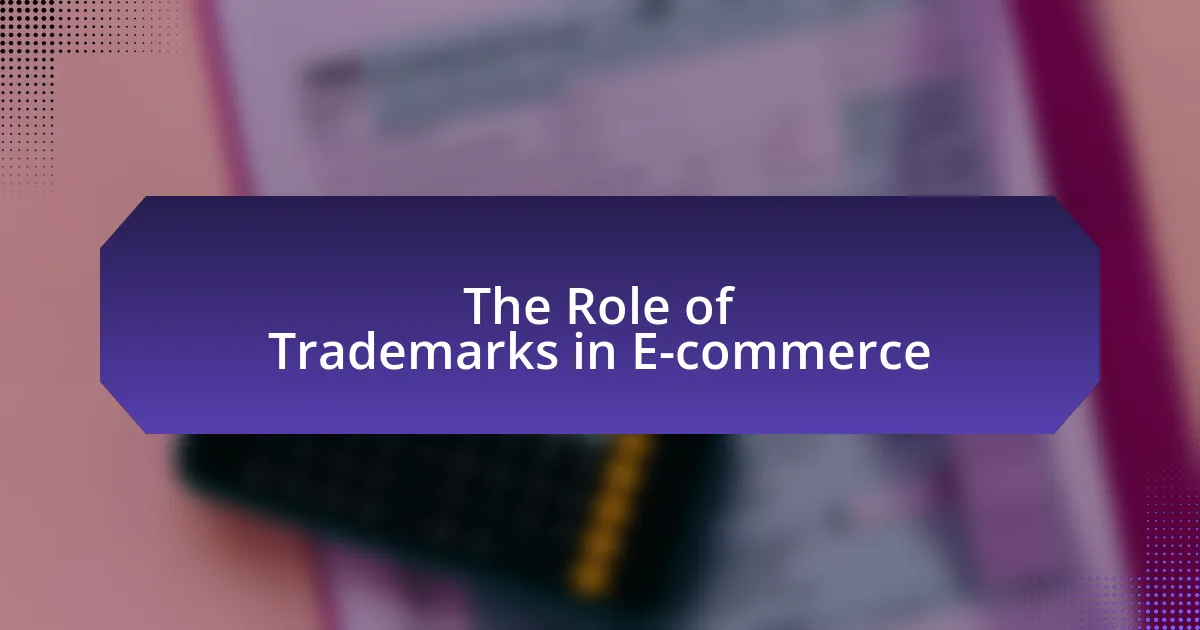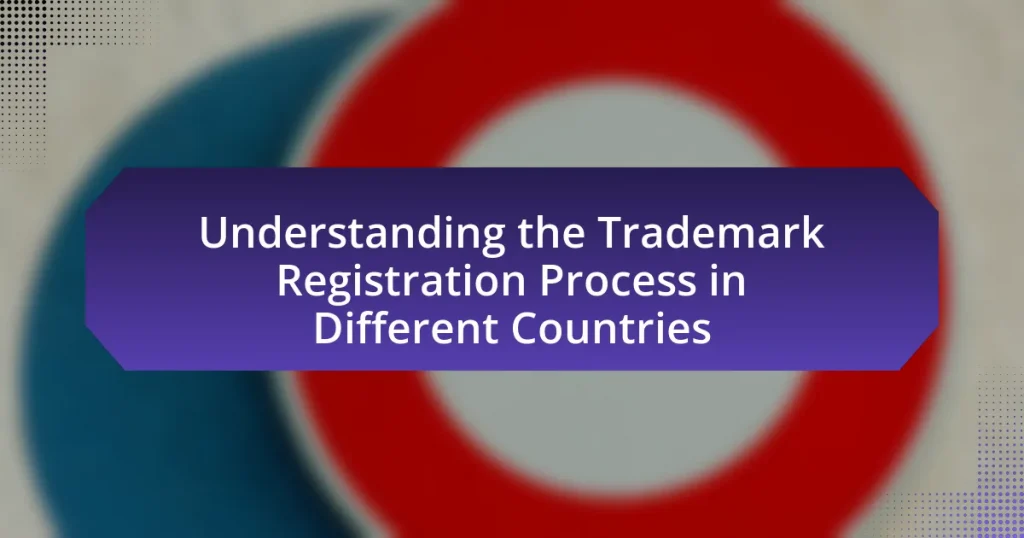Trademarks are essential in e-commerce, serving as identifiers of brand identity and protecting intellectual property. They help consumers distinguish between products, fostering trust and loyalty, with studies indicating that a significant percentage of consumers prefer recognizable brands. The article explores the functions of trademarks in online marketplaces, their legal protections, and the challenges they face, such as counterfeiting and infringement. It also discusses strategies for businesses to manage and enforce their trademarks effectively, the impact of consumer perception on brand recognition, and emerging trends in trademark protection within the evolving e-commerce landscape.

What is the Role of Trademarks in E-commerce?
Trademarks play a crucial role in e-commerce by providing brand identification and protecting intellectual property. They help consumers distinguish between different products and services, fostering brand loyalty and trust. According to the International Trademark Association, 79% of consumers are more likely to purchase from a brand they recognize, highlighting the importance of trademarks in driving sales and enhancing customer confidence in online transactions. Additionally, trademarks serve as a legal safeguard against counterfeiting and infringement, ensuring that businesses can maintain their reputation and market position in the competitive e-commerce landscape.
How do trademarks function within the e-commerce landscape?
Trademarks function as essential identifiers of source and quality in the e-commerce landscape, helping consumers distinguish between different products and brands. They provide legal protection against unauthorized use, ensuring that businesses can maintain their brand reputation and consumer trust. For instance, a study by the International Trademark Association found that 79% of consumers are more likely to purchase from a brand they recognize, highlighting the importance of trademarks in driving online sales. Additionally, trademarks can enhance search engine visibility and brand loyalty, as they often appear in product listings and advertisements, further solidifying their role in e-commerce.
What are the key elements of trademarks in e-commerce?
The key elements of trademarks in e-commerce include distinctiveness, registration, enforcement, and consumer recognition. Distinctiveness ensures that a trademark is unique and capable of identifying the source of goods or services, which is crucial for brand differentiation in a crowded online marketplace. Registration of trademarks provides legal protection and exclusive rights, making it easier for businesses to defend their brands against infringement. Enforcement involves actively monitoring and taking action against unauthorized use, which is essential to maintain brand integrity and consumer trust. Lastly, consumer recognition is vital, as it reflects the effectiveness of a trademark in establishing brand loyalty and influencing purchasing decisions. These elements collectively contribute to the strength and value of trademarks in the e-commerce landscape.
How do trademarks differentiate products in online marketplaces?
Trademarks differentiate products in online marketplaces by providing unique identifiers that signify the source of goods or services. These identifiers, which can include logos, brand names, and slogans, help consumers distinguish between competing products, thereby reducing confusion and enhancing brand recognition. For instance, a study by the International Trademark Association found that 79% of consumers are more likely to purchase a product if they recognize its trademark, illustrating the importance of trademarks in influencing consumer behavior and decision-making in e-commerce.
Why are trademarks important for e-commerce businesses?
Trademarks are crucial for e-commerce businesses because they protect brand identity and consumer trust. A registered trademark distinguishes a company’s products or services from competitors, helping to prevent confusion in the marketplace. According to the United States Patent and Trademark Office, trademarks can increase a business’s value by establishing brand recognition and loyalty, which are essential for customer retention in the competitive online environment. Furthermore, trademarks provide legal protection against infringement, allowing businesses to take action against unauthorized use of their brand, thereby safeguarding their reputation and market position.
What legal protections do trademarks provide to online sellers?
Trademarks provide online sellers with legal protections that prevent unauthorized use of their brand identifiers, such as logos and names. These protections help maintain brand integrity and consumer trust by allowing sellers to take legal action against counterfeiters and infringers. For instance, under the Lanham Act in the United States, trademark owners can sue for damages and seek injunctions against parties that misuse their trademarks, thereby safeguarding their market position and reputation. This legal framework ensures that online sellers can effectively protect their intellectual property and maintain a competitive edge in the e-commerce landscape.
How do trademarks enhance brand recognition in e-commerce?
Trademarks enhance brand recognition in e-commerce by providing a unique identifier for products and services, which helps consumers easily distinguish between different offerings. This distinctiveness fosters consumer trust and loyalty, as customers are more likely to purchase from brands they recognize and associate with quality. Research indicates that 77% of consumers are more likely to buy from a brand they recognize, highlighting the importance of trademarks in establishing a memorable presence in the online marketplace. Additionally, trademarks can protect brand reputation by preventing unauthorized use, ensuring that consumers receive the expected quality associated with the brand.

What challenges do trademarks face in the e-commerce environment?
Trademarks face significant challenges in the e-commerce environment, primarily due to the ease of counterfeiting and the difficulty of enforcing trademark rights online. The rapid growth of online marketplaces allows counterfeit goods to be sold alongside legitimate products, often making it hard for consumers to distinguish between them. According to a report by the International Trademark Association, counterfeiting costs the global economy over $500 billion annually, highlighting the scale of the issue. Additionally, the anonymity of online sellers complicates the identification and prosecution of trademark infringement, as many operate without clear accountability. This environment creates a persistent risk for brand dilution and consumer confusion, undermining the value of trademarks in e-commerce.
How does online infringement affect trademark owners?
Online infringement significantly undermines the rights and interests of trademark owners by diluting brand identity and causing financial losses. When unauthorized parties use a trademark online, it can confuse consumers, leading to a loss of trust and potential sales for the legitimate trademark owner. According to a report by the International Trademark Association, 75% of consumers have encountered counterfeit goods online, which illustrates the widespread impact of infringement on brand reputation and revenue. Additionally, trademark owners may incur substantial legal costs in efforts to enforce their rights and protect their brand from misuse, further straining their resources.
What are common types of trademark infringement in e-commerce?
Common types of trademark infringement in e-commerce include unauthorized use of trademarks, counterfeiting, and keyword advertising. Unauthorized use occurs when a seller uses a trademarked name or logo without permission, misleading consumers about the origin of the goods. Counterfeiting involves creating fake products that bear a trademark identical or substantially similar to a registered trademark, which can deceive consumers into believing they are purchasing genuine items. Keyword advertising infringement happens when a business uses a competitor’s trademark as a keyword in online advertising, causing confusion among consumers regarding the source of the products. These practices violate trademark laws and can lead to legal consequences for the infringing parties.
How can businesses protect their trademarks from online threats?
Businesses can protect their trademarks from online threats by implementing a combination of proactive monitoring, legal registration, and enforcement strategies. Proactive monitoring involves regularly checking online platforms for unauthorized use of trademarks, which can be facilitated by tools that track brand mentions and potential infringements. Legal registration of trademarks with relevant authorities, such as the United States Patent and Trademark Office, provides legal grounds for enforcement against infringers. Additionally, businesses should enforce their rights by sending cease-and-desist letters to violators and pursuing legal action when necessary. According to the International Trademark Association, effective trademark protection can significantly reduce the risk of brand dilution and consumer confusion, thereby safeguarding a company’s reputation and market position.
What role does consumer perception play in trademark effectiveness?
Consumer perception is crucial for trademark effectiveness as it directly influences brand recognition, loyalty, and purchasing decisions. When consumers perceive a trademark positively, they are more likely to associate it with quality and reliability, which enhances the brand’s market position. Research indicates that 77% of consumers make purchases based on brand recognition, highlighting the importance of a favorable consumer perception in driving sales and fostering brand loyalty. Additionally, trademarks that resonate well with consumers can differentiate a brand in a crowded marketplace, making it essential for businesses to cultivate and maintain a positive image to maximize their trademark’s effectiveness.
How do trademarks influence consumer trust in e-commerce?
Trademarks significantly influence consumer trust in e-commerce by serving as indicators of quality and reliability. When consumers recognize a trademark, they associate it with a certain level of product quality and customer service, which can lead to increased confidence in their purchasing decisions. Research indicates that 81% of consumers are more likely to purchase from a brand they recognize, highlighting the importance of brand familiarity in building trust. Additionally, trademarks help to differentiate products in a crowded marketplace, reducing the perceived risk associated with online shopping. This differentiation is crucial, as 70% of consumers report that they prefer to buy from brands they trust, further reinforcing the role of trademarks in fostering consumer trust in e-commerce.
What impact do trademarks have on consumer purchasing decisions?
Trademarks significantly influence consumer purchasing decisions by serving as indicators of quality and brand reputation. Consumers often rely on trademarks to identify products that meet their expectations for reliability and performance, which can lead to brand loyalty. Research indicates that 77% of consumers make purchasing decisions based on brand recognition, highlighting the importance of trademarks in guiding choices. Additionally, trademarks can evoke emotional connections and trust, further impacting consumer behavior in e-commerce settings.

How can businesses effectively manage trademarks in e-commerce?
Businesses can effectively manage trademarks in e-commerce by implementing a comprehensive strategy that includes regular monitoring, registration, and enforcement of their trademarks. Regular monitoring allows businesses to identify potential infringements or misuse of their trademarks online, which is crucial given the vastness of e-commerce platforms. Registration of trademarks with relevant authorities, such as the United States Patent and Trademark Office, provides legal protection and establishes ownership. Enforcement actions, including sending cease-and-desist letters or pursuing legal action against infringers, help maintain brand integrity and prevent dilution. According to a report by the International Trademark Association, businesses that actively manage their trademarks can reduce the risk of infringement by up to 30%, highlighting the importance of a proactive approach in the digital marketplace.
What strategies can e-commerce businesses use to register trademarks?
E-commerce businesses can use several strategies to register trademarks effectively. First, they should conduct thorough trademark searches to ensure that their desired trademarks are not already in use, which helps avoid potential legal disputes. Second, businesses should choose distinctive trademarks that are unique and memorable, as this increases the likelihood of successful registration. Third, they should file applications with the appropriate trademark office, such as the United States Patent and Trademark Office (USPTO), providing all required documentation and fees. Additionally, e-commerce businesses can consider using legal professionals specializing in intellectual property to navigate the complexities of trademark law. These strategies are supported by the fact that a well-researched and distinct trademark is more likely to be granted protection, as evidenced by the USPTO’s guidelines on trademark registration.
What are the steps involved in the trademark registration process?
The steps involved in the trademark registration process include conducting a trademark search, filing an application with the relevant trademark office, responding to any office actions, and receiving the trademark registration certificate.
First, conducting a trademark search ensures that the desired trademark does not conflict with existing trademarks, which can prevent potential legal issues. Next, filing an application involves submitting the necessary forms and fees to the trademark office, detailing the trademark and its intended use. After submission, the trademark office may issue office actions requiring responses to clarify or amend the application. Finally, if the application meets all requirements and no oppositions are filed, the trademark office issues a registration certificate, granting exclusive rights to the trademark.
How can businesses ensure their trademarks are enforceable online?
Businesses can ensure their trademarks are enforceable online by registering their trademarks with the appropriate governmental authorities and actively monitoring their use in digital spaces. Registration provides legal recognition and establishes a public record of ownership, which is crucial for enforcement. Additionally, businesses should implement a robust online monitoring system to detect unauthorized use or infringement of their trademarks on websites, social media, and e-commerce platforms. According to the United States Patent and Trademark Office, registered trademarks are afforded stronger legal protections, making it easier for businesses to take action against infringers. Regularly updating and enforcing trademark rights through cease-and-desist letters or legal action further solidifies their enforceability in the online environment.
What best practices should e-commerce businesses follow for trademark management?
E-commerce businesses should implement proactive trademark management practices to protect their brand identity and avoid legal disputes. These practices include conducting thorough trademark searches before launching products to ensure no existing trademarks conflict, registering trademarks with relevant authorities to secure legal rights, and monitoring the marketplace for potential infringements. According to the United States Patent and Trademark Office, registered trademarks provide stronger legal protection and can deter unauthorized use. Additionally, e-commerce businesses should educate their employees about trademark policies and establish clear procedures for reporting potential infringements, which can help maintain brand integrity and reduce the risk of costly litigation.
How can businesses monitor and enforce their trademarks effectively?
Businesses can monitor and enforce their trademarks effectively by implementing a combination of proactive monitoring strategies and legal enforcement actions. Proactive monitoring includes using automated tools to track online mentions of trademarks, conducting regular searches on e-commerce platforms, and utilizing social media monitoring to identify potential infringements. Legal enforcement actions involve sending cease-and-desist letters to infringers, filing complaints with relevant authorities, and pursuing litigation when necessary. According to a study by the International Trademark Association, businesses that actively monitor their trademarks are 30% more likely to successfully enforce their rights compared to those that do not engage in monitoring.
What resources are available for trademark education and support?
Resources available for trademark education and support include the United States Patent and Trademark Office (USPTO), which offers online tutorials, webinars, and a comprehensive trademark database. Additionally, organizations such as the International Trademark Association (INTA) provide educational materials, seminars, and networking opportunities for trademark professionals. Law schools and universities often have intellectual property programs that include trademark education, while various online platforms offer courses on trademark law and practice. These resources collectively enhance understanding and navigation of trademark issues in e-commerce.
What are the future trends in trademarks and e-commerce?
Future trends in trademarks and e-commerce include the increasing importance of digital trademarks, the rise of blockchain technology for trademark protection, and the growing emphasis on brand authenticity and consumer trust. Digital trademarks are becoming essential as e-commerce expands, with businesses needing to secure their online identities across multiple platforms. Blockchain technology offers a decentralized method for registering and verifying trademarks, enhancing protection against counterfeiting and infringement. Additionally, as consumers become more discerning, brands are focusing on authenticity, leading to stricter enforcement of trademark rights to maintain consumer trust and loyalty. These trends reflect the evolving landscape of e-commerce and the necessity for robust trademark strategies.
How is technology changing the landscape of trademark protection in e-commerce?
Technology is significantly transforming trademark protection in e-commerce by enhancing monitoring and enforcement capabilities. Advanced algorithms and artificial intelligence tools enable brands to track unauthorized use of their trademarks across various online platforms in real-time. For instance, machine learning models can analyze vast amounts of data to identify potential infringements, allowing companies to respond swiftly to violations. Additionally, blockchain technology is being utilized to create immutable records of trademark registrations, which can help in proving ownership and authenticity. According to a report by the World Intellectual Property Organization, the use of technology in trademark protection has led to a 30% increase in successful enforcement actions against counterfeit goods in e-commerce.
What emerging challenges should businesses be aware of regarding trademarks?
Businesses should be aware of the emerging challenges of trademark infringement in the digital landscape, particularly due to the rise of e-commerce platforms. The proliferation of online marketplaces has led to increased instances of counterfeit goods and unauthorized use of trademarks, making it difficult for businesses to protect their brand identity. According to a report by the International Trademark Association, the global economic impact of counterfeiting is estimated to reach $4.2 trillion by 2022, highlighting the urgency for businesses to implement robust trademark enforcement strategies. Additionally, the complexities of international trademark laws can create challenges for businesses operating across borders, as different jurisdictions may have varying standards for trademark protection.
What practical tips can e-commerce businesses implement for trademark success?
E-commerce businesses can achieve trademark success by conducting thorough trademark searches before launching products to ensure their brand names and logos are unique. This proactive approach minimizes the risk of infringement and legal disputes, as evidenced by the fact that over 50% of trademark disputes arise from similar names in the same industry. Additionally, registering trademarks with the appropriate authorities, such as the United States Patent and Trademark Office, provides legal protection and exclusive rights to use the mark, which is crucial for brand identity. Regularly monitoring the market for potential infringements and enforcing trademark rights when necessary further strengthens a brand’s position, as companies that actively protect their trademarks are more likely to maintain their market share and brand reputation.



